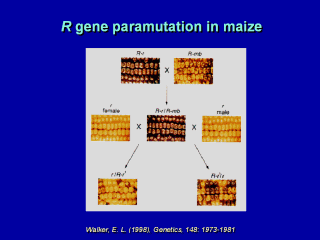| front |1 |2 |3 |4 |5 |6 |7 |8 |9 |10 |11 |12 |13 |14 |15 |16 |17 |18 |19 |20 |21 |22 |23 |24 |25 |26 |27 |28 |29 |30 |31 |32 |33 |review |
 |
This is illustrated here in a figure taken from
a recent paper by Elsbeth Walker. A heterozygote between the paramutable R-r allele and the paramutagenic R-mb allele gives rise to a strongly pigmented F1 heterozygote. When the heterozygote is used as the male parent in a backcross to a colorless allele, the resulting heterozygote is very much more weakly pigmented than its parent. You will also note that the effect appears to be more pronounced when the paramutable R-r allele is transmitted through the male than through the female. Now letís look at whatís known about the molecular basis paramutagenicity and paramutability. |